Imagine a magic potion that will help decrease customer acquisition costs, increase retention, capture more lifetime value, and decrease the time to pay back from customers.
Jackie Cook and the team at Vendasta have been working to concoct that potion – Cloud Juice.
Product-Led Growth as a Business Growth Strategy
Product-led growth is defined as “instances where product usage serves as the primary driver of user acquisition, retention, and expansion”. Openview Partners originally coined the term (and came up with this definition) but it has since been used as a growth strategy by many others trying to grow their companies.
The concept of product-led growth (PLG) is not new. You probably already know and use it all the time. Synonyms for PLG include ‘freemium’, ‘try-before-you-buy’, ‘SaaS 2.0’ and ‘free trial’. Starting to ring a bell?
To boil the term down even further, product-led growth leans on a beautiful product experience in order to grow a customer base. Win customers by delivering value first before asking them to make a purchase.
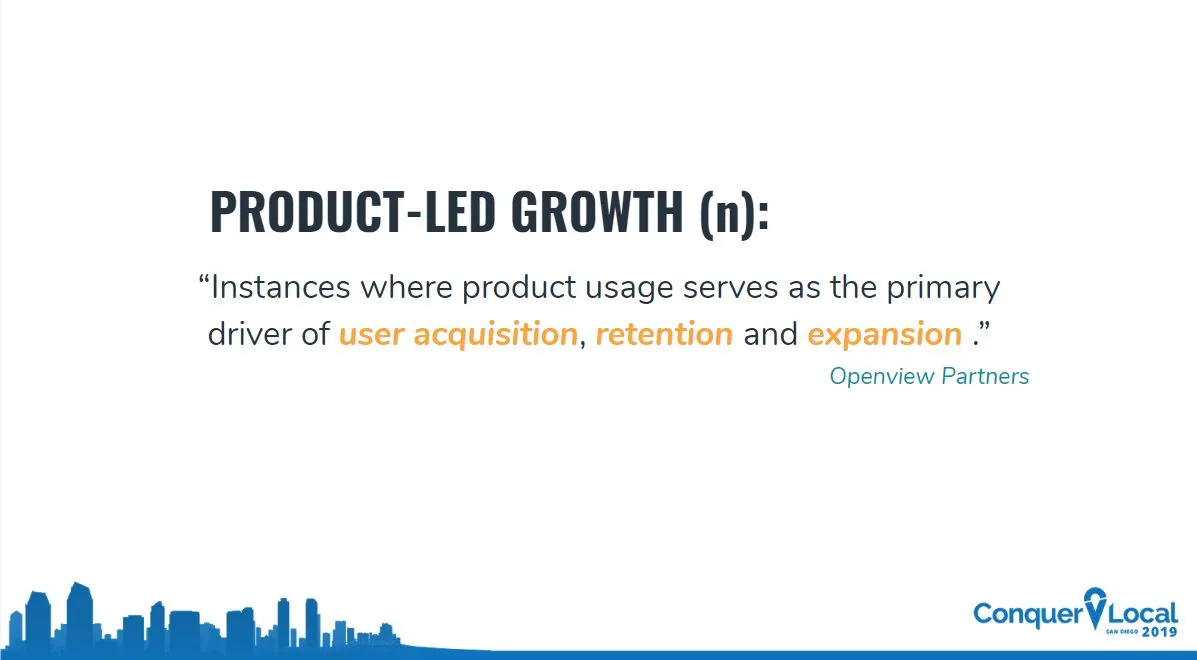
Product-led growth is a business growth strategy and a business model. Though the product is extremely important, the concept of product-led growth is an entire go-to-market strategy that will impact the way companies go about their marketing, the direction their salespeople take conversations with prospects and the choice in pricing strategy.
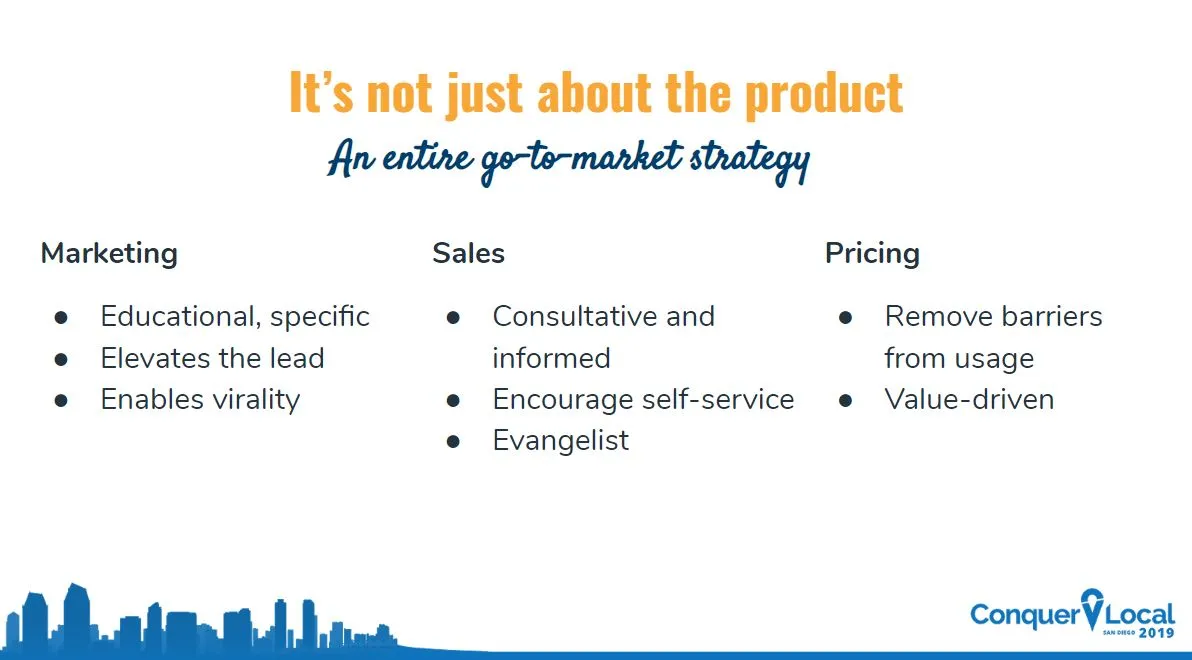
Marketing
Using the product-led growth strategy, marketing uses the product as the channel.
The goal for marketers is to show prospects the value offered and put their product at every step of the customer journey. The idea is to earn the trust of customers by allowing them to use the product, obtain value from that product, and fall in love with the product so they can’t wait to unlock more.
Marketing works to get people using the product. Once people are in the product and are actively using it, the marketing becomes about providing a seamless experience that customers can have instantly, without friction or assistance. Marketers work to build excitement about the opportunities the product creates for the customer and earn trust by delivering value at every step.
One of the key parts to product-led growth is providing users with the ability to demonstrate whether the product addresses their needs. The user has control over the upgrades they choose to purchase and can easily make those purchases whenever they want on their own. Product-led growth has the ability to increase conversion rates by informing the customer and offering them the opportunity to make purchases immediately.
An extremely exciting thing for marketers is that product-led growth boosts virality. When people love your product, they will share it. Product-led growth enables word of mouth marketing by delivering delightful experiences.
Sales
One of the most important things to know is product-led growth does not remove the need for salespeople. In fact, quite the opposite. Product-led growth accelerates sales.
The salesperson’s role changes. Instead of focusing so much on information dumping and pushing products, the salesperson’s role becomes about being a consultant to the individual needs of the customer. Since the customer has the ability to try the product on their own, a salesperson can help connect the dots between what the product does, how others are using it, and how it can immediately address their needs. Salespeople identify what barriers are in front of the customer and how to remove them. Sales becomes about customer success rather than product pushing.
Salespeople position themselves as product experts. The customer already knows what they like and do not like about what they’ve already seen. The salespeople are there to work with the information they have collected about the customer and use it to promote customer success with the best advice they can. This concept is the epitome of consultative selling.
Pricing
Product-led growth pricing is about removing barriers. It is about how you can give the customer the experience they need to engage, see value and be motivated to see more.
As product-led growth is synonymous with ‘freemium’, it is important to note the customer must have an opportunity to experience the product without making a purchase. Once they are in the product that’s where information about upgrades and paid features should be marketed.
This pricing model is great for customers because it reduces the chance for buyers remorse. They know what they will be getting and they already trust you to deliver delightful results.
[adrotate banner=”120″]
Product-Led Growth Changes the Customer Acquisition Model
The traditional acquisition model looks like this:
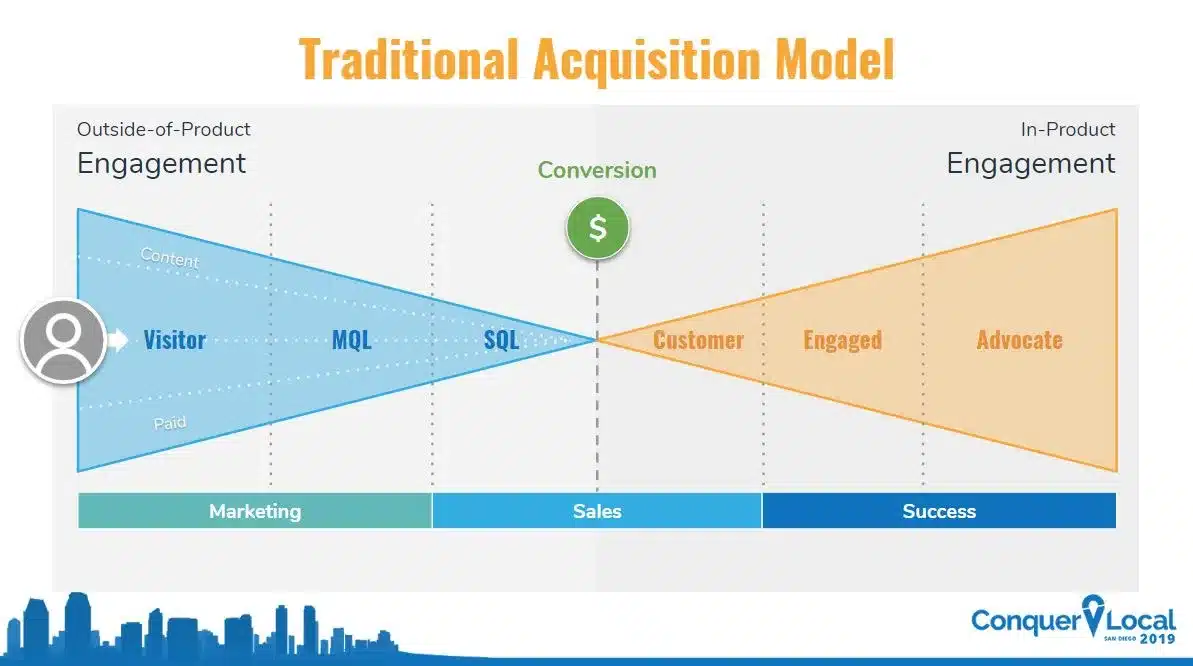
Once the salespeople get these leads, they give them more information and talk about the problems the customer needs to solve. At this point, the lead is at the conversion point and may purchase your product to become a customer.
As a customer, they are then passed on to the success team to learn how to use the product and be as successful as they can be. Finally, once the customer has gone through all of these steps, they will hopefully become an advocate for the company.
This model creates silos. The marketing team passes on to sales who passes on to success. It is not a business growth strategy, it’s a game of hot potato.
Additionally, the product experience doesn’t even begin until post-conversion. The customer hasn’t had the opportunity to play around until they have signed the cheque.
Product-Led Growth Customer Acquisition
With the business growth strategy product-led growth, the customer acquisition model changes. The product leads the initial customer experience.
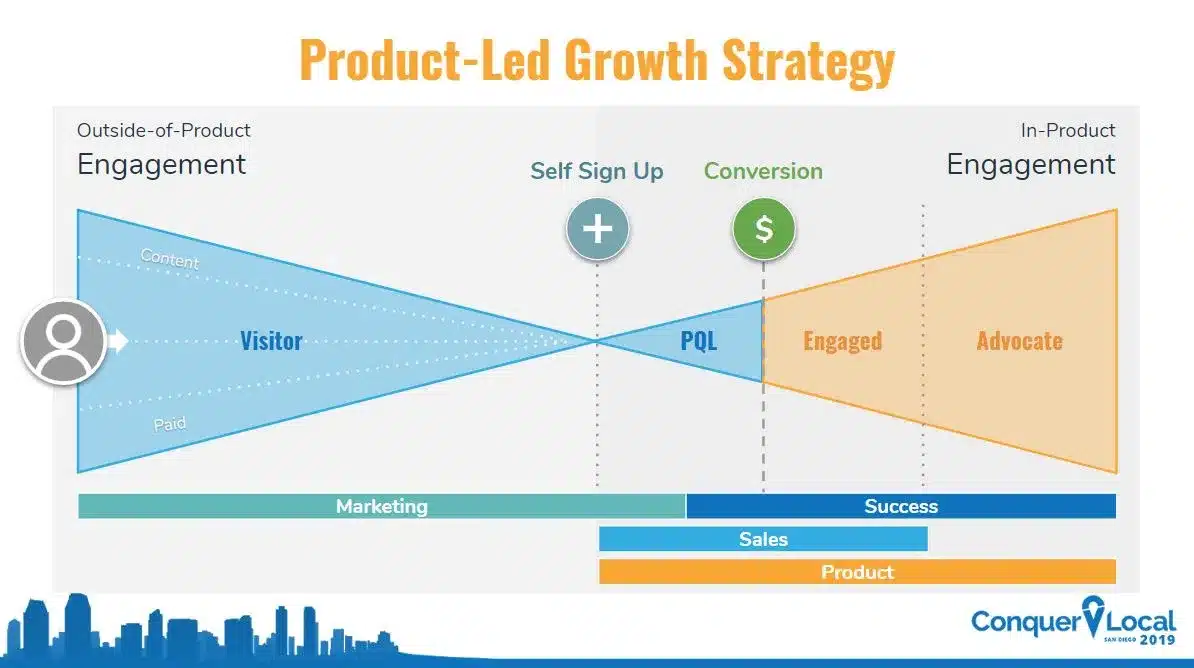
The Product-Led Growth Strategy changes three things about the traditional customer acquisition model.
- The product leads the initial customer experience
- Customer success is an outcome, not just a team
- Everyone is a customer
The marketing team works to bring customers by delivering value through thought leadership, information sharing and other helpful content and attracting attention through paid advertising, however, the big push goes towards getting the customer to try it out for themselves.
Once the visitor has signed up themselves, they become PQLs or product qualified leads who get to experience the value of the product first hand. Instead of marketing passing off the customer directly to the salespeople, the salespeople integrate themselves into the process by helping the user jump over hurdles and to help them understand the value and the opportunity the gated product offers.
The sales and success teams work together to help the customer be engaged and be successful with the product. Everyone is responsible for the success of that customer, they just help usher them in different parts their journey.
In other words, the product is the primary avenue for engagement. The product leads the experience with the brand. The teams work together cross-functionally to help the customer succeed. Everyone who signs up becomes a customer because they may find value using your product.
3 Reasons To Choose Product-Led Growth
1. Consumers Want It
“Three out of four B2B buyers want to self-educate rather than talk to sales representations to learn about products.” Forrester
As consumers, we expect and demand the ability to use the product first. Buyers in today’s environment like to be informed and enlightened through easily accessible information they can understand themselves.
People purchasing B2B software today expect the same kind of process as when they buy software in their day to day lives. Could you imagine having to download a white-paper, waiting to be qualified by marketing to be sent to a sales development representative and then get an hour-long presentation from a business development representative to start streaming Netflix? Absolutely not.
People know exactly what they want and they are too time-starved to take hours out of their day to collect information. People like to be able to find information at their own pace, on their own schedule which basically means immediately. Because of these consumer expectations and habits, product-led growth is the perfect business growth strategy.
2. Customer Acquisition Cost Is on The Rise
Getting customers is increasingly more expensive. Not only that, but the customer’s willingness to pay is also decreasing. Profitwell has found CACs have increased by over 55% in the last five years, while willingness to pay has decreased by 30%. That’s not good news.
In addition to paying more for customers who want to pay less, the cost per mille (thousand eyeballs) is also increasing. The cost on Twitter has gone up by 20%, LinkedIn by 44% and Facebook by a whopping 171%.
3. Product-Led Growth Works
Companies who implement product-led growth strategies are 2.2 times more valuable than companies who did not.
Openview conducted a study comparing companies who used product-led growth to those who did not. The results showed outperformance by product-led growth companies in almost every area.
Faster revenue growth, higher gross margin, and outperformed on the rule of 40, and outperformed on their revenue multiple.

The companies who are going to win in this marketplace will be the ones who show value immediately, build trust, and have an ongoing relationship to continue to evaluate needs and solve customer problems.
How To Get Started with Product-Led Growth
At Vendasta, we are driven to help our partners succeed. Product-led growth is a growth strategy we were excited share but needed to prove it worked for ourselves in order to help our partners use it. So here’s what we did:
-
Deliver Value Immediately
The goal is to find out what our partners need and show that we have the opportunity and ability to solve that problem. Deliver value immediately in a simple, self-serve, friction-free way.
To implement this concept, we developed a free signup option and a $50 starter subscription to increase accessibility for customers. Initially, we had our doubts. Will this cannibalize revenue? Will a simplified version of our platform be enough? Will people engage if we aren’t there to hold their hand through it?
Here’s what happened.
We grew.
Our CAC dropped, our time to pay back CAC got shorter, and the percentage of converted leads to paid subscriptions more than doubled.
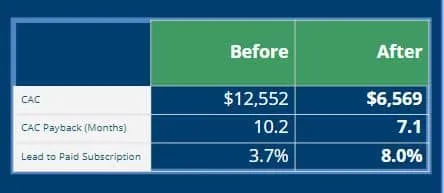
2. Drive Engagement
Once customers start using the platform, our goal is to gain information and insight into how to engage with them more. It isn’t enough to just get them in the door. It’s all about how to get the customer to depend on what you’re offering. If there is no reason for the user to come back, we would just be burning hard-earned leads.
3. Predict Customer Needs
Understanding customer needs is the first piece. Our goal is to know our customers so well we can predict what they will need and their journey as a customer. With those insights, we could share what their experience could look like and deliver value at the highest level.
By knowing who they are, what they need, and what they have done in the platform, we can help them succeed through specific, customer-success focused help. What this means is that when we see the partner has struggled at a certain point, that’s where we can step in to remove barriers.
Takeaways
Product-led growth is a go-to-market strategy and business growth strategy that will transform the way companies do business. In this environment, it is what customers expect. Product-led growth is all about letting the product speak for itself and showing immediate value to the customer in order to build their trust.
There is no magic potion that will guarantee your success in the ever-changing business landscape. Customer acquisition and customer retention will always require vigilance and consistency in adapting your strategy.
But the verdict’s in. Product-led growth is basically the strategic equivalent to a magic potion. With product-led growth as a business growth strategy, decreased customer acquisition costs, increased retention, more lifetime value, and decreased time to pay back from customers can be a reality.


